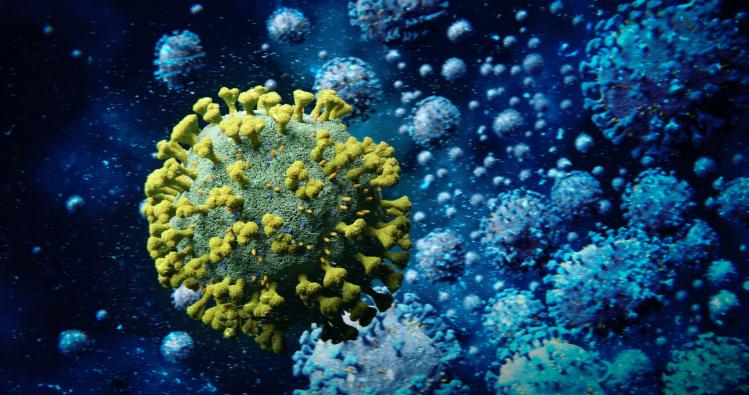
The coronavirus pandemic has dramatically changed the way Americans live, both individually and collectively. But has it altered the way we think about the basic fabric of our lives? Not yet. I think it should, though—especially in ways that strengthen the vision of interconnected creation outlined by Pope Francis in Laudato si’.
Influenced by literal readings of Scripture as well as an implicitly Cartesian picture of the world, many Americans operate with three sets of sharp distinctions: 1) between living and nonliving beings; 2) between different types of living beings, arranged in a rigid hierarchy; and 3) between inert matter and vibrant mind or soul. But if we start to consider how viruses operate, all three sets of distinctions begin to dissolve, and interconnections take center stage.
What is a virus? It’s an aggressive snippet of DNA (or RNA in the case of retroviruses). Many viruses operate by fusing themselves with the outer membrane of the target cell, and then working their way toward the nucleus. Once there, they take over the cell’s genetic mechanisms, reprogramming the cell to make more virions (single particles of the virus) rather than fulfill its normal functions. Eventually, the virions overwhelm and rupture the host cell. Newly liberated, the virions go on to seek other cells to infiltrate, moving from cell to cell and from organism to organism.
Does that mean a virus is alive? That’s a difficult question. Some scientists say no, they are more like chemistry sets. Unlike viruses, living beings autonomously consume, process, and expend energy. Moreover, a virus cannot reproduce on its own through a process of cell division, in the way a simple amoeba can. But others argue that a virus is alive, or at least intermittently alive. It may not reproduce itself, but it does actively organize its own reproduction. Maybe there is a middle ground: in a fascinating article in Scientific American (December 2004), Luis P. Villarreal argues there is a “spectrum...between what is certainly alive and what is not.” Villarreal, the founding director of the Center for Virus Research at UC Irvine, asks us to think of life as “an emergent property of a collection of certain nonliving things.”
Many people also assume there are rigid boundaries between various forms of living beings, whether that assumption comes from the first chapters of Genesis or a simplistic understanding of evolution. They think that bacteria are one thing, plants yet another, animals a different thing, and people something else entirely. They also assume that the development from simple to complex life forms is neat and linear, so that each more complex being that emerges includes everything in the category below and adds something new and bigger, like a set of Russian dolls.
But viruses show us that the development of complex life forms is itself staggeringly complex and even messy. Villarreal notes that between 113 and 223 genes present in both the genetic makeup of bacteria and human beings are absent in intermediate forms of life, like yeast. He suspects that those genes did not disappear and then re-evolve, but rather were somehow inserted into both bacteria and human beings by the same virus. Evolution’s traveling salesmen, viruses peddle their genetic wares near and far. They create surprising links between vastly different types of living entities, all of which are connected by their dependence on the same four building blocks that make up the DNA of all living things.
Finally, viruses challenge the idea that non-living matter is inert and static. Viruses may not be alive, but they are lively. And really, so is all matter. Inertness is an illusion. In the past century, we have learned that each atom of matter is full of motion and energy, as electrons circle the atom’s protons, neutrons, and nucleus. Chemical reactions occur not only in lab experiments, but inside human beings. More broadly, we are increasingly aware of how our brain and body chemistry affects our minds and sense of self. Serotonin influences mood and affect. Rising and falling levels of estrogen and testosterone throughout life mark not only our physical shape, but also our dispositions and judgment. We are thoroughly embodied creatures, not minds trapped in inert matter.
When Pope Francis published Laudato si’ on May 24, 2015, he couldn’t have known that five years later we’d be living through a pandemic. But that fact has only sharpened the encyclical’s prophetic call to care for our common home, and each other. Its key theme is that “everything in the world is connected,” from the well-being of the poor to the flourishing of the planet itself. Francis vividly expresses these connections when he calls the Earth our sister and our mother. Unfortunately, many people treat these images as mere metaphors, or dismiss them as instances of poetic license. But they are literally as well as poetically true, as the nature and functions of viruses help us to see. Nature is not merely the setting for the drama of human existence. Other living beings are not merely part of the chorus. Even the scenery is not mere backdrop. Everything around us has an integral part to play in the story of creation.

